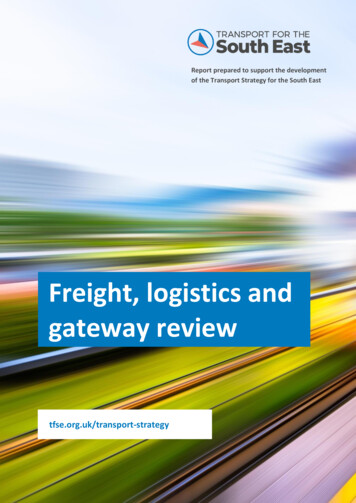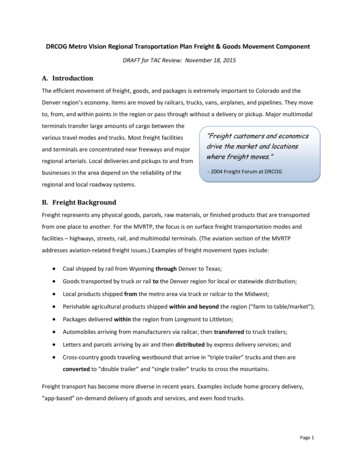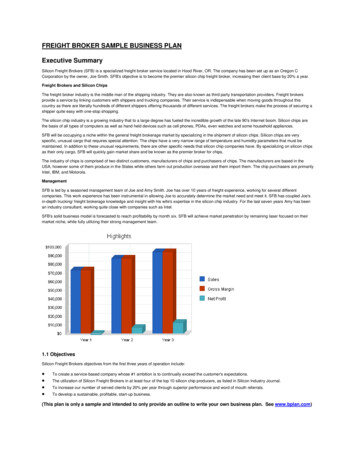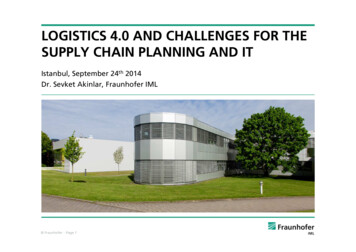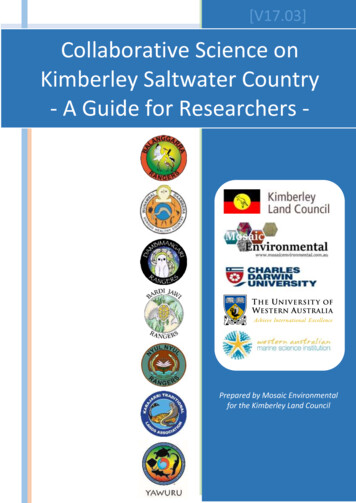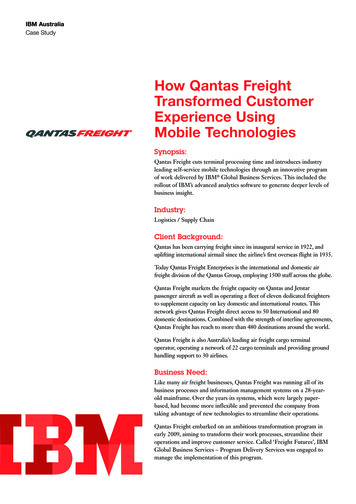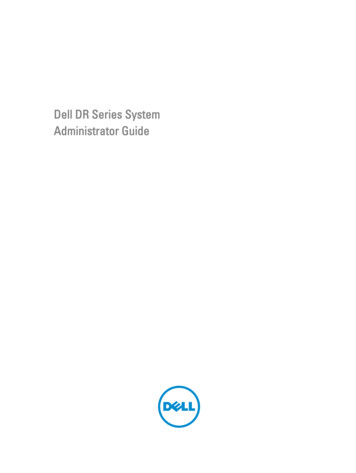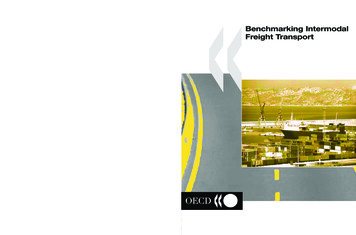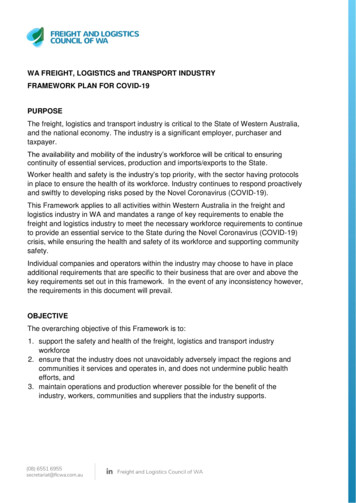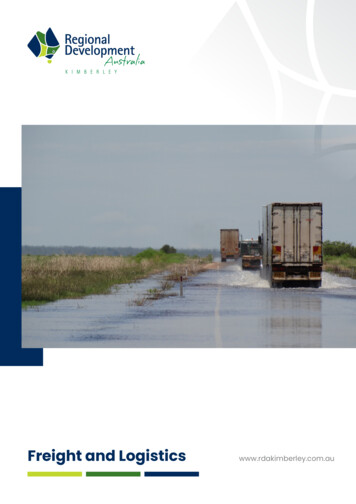
Transcription
Freight and Logisticswww.rdakimberley.com.au
Businessin the KimberleyMap of the Kimberley RegionBusiness in the Kimberley2
Freight and LogisticsExecutive SummaryThis regional brief outlines the state of the Freight andLogistic industries, its opportunities, and its challengesand highlights recommendations to enable long termsustainable growth of the sector for the benefit the ofKimberley and its people.Efficient and reliable logistics is one of the most criticalfactors in determining the competitiveness of any region.The freight and logistics industry contribute approx. 555.3M per annum or 10.78% of gross revenue andemploys 6.5% of the Kimberley work force.The Kimberley freight task is characterised by low volumesover vast distances with most bulk products freighted byvia road or shipping and very little air freight. Significantprojects from mining, agriculture, and aquacultureindustries will increase the aggregate scale of commoditiesand freight and logistic requirements in the medium tolong term. Infrastructure must be able to meet this growingdemand.The region is serviced by key roads linking north-southGreat Northern Highway and north-east by VictoriaHighway. These key freight paths can become cut offduring seasonal events of fire, flood or cyclones. Urgentupgrades to ensure weather resilience and upgrading ofsingle-lane bridges is required. Roads linking east-westTanami Road and Buntine Highway are not fit for purposeand timely upgrades to these roads are critical.Shipping is via three regional ports in Broome, Derby,and Wyndham and lesser ports in Yampi Sound. Currentinfrastructure lacks adequate bulk handling or cool storagefacilities. The region is missing a critical shipping lineBusiness in the Kimberleyservice of cargo containers for import and export of smallscale commodities. There are proposed developmentsfor a Kimberley Marine Supply Base along with containercargo facilities to ease this burden.Two main regional airports along with smaller airportsservice the region. However, airfreight is highly constrictedby lack of facilities and low aggregate commodityvolumes. It requires development or extension to existinginfrastructure to include air cargo carrier access andairside facilities. Consideration should be given to bestuse of the RAAF Curtin airbase, which has the secondlargest runway in Australia and capacity for cool storagedevelopment.RDAK Recommendation: Australian Government investment in a ensuring allbridges on National Highway One (Great NorthernHighway) are dual lane and that a new bridgeover the Ord River is constructed to remove freightimpediments, and freight from the Kununurra DiversionDam wall, with this new bridge becoming part if thenational highway grid. Australian Government undertake a review of the useof Curtain Air Base, so it contributes more positively tothe economic development of the Kimberley region. Australian Government proactively seek to authoriseWestern Australian Government officials based inthe region to undertake Commonwealth requiredinspections at Ports.3
Freight and LogisticsThe Snapshot 555.3M per annum or10.78% GRPKey roads needupgradesEmploys 6.5% ofworkforceLow volumes over vastdistancesAirfreight is constricted by lackof facilitiesFreightpredominately viaroad or shipSignificant projectsfrom diverse sectorswill increase logisticdemandIndustry OverviewEfficient and reliable logistics is one of the most criticalfactors in determining the competitiveness of a region, asinefficient and or unreliable logistics adds cost and causesdelays in the delivery of goods and services to and froman area, thereby decreasing competitiveness1.The Freight and Logistics industries in the Kimberleygenerates a Gross Revenue of approximately 555.322million dollars per annum. It employs around 987 people,or 6.5%3 of jobs in the region.The Kimberley is one-sixth of Western Australia’s landmassspanning 419,558 km² - twice the size of Victoria. It has apopulation of 36,0144 and is one of the least peopled placeson earth. The closest capital to the region is Darwin located880kms east, and Perth located 2200km south.Compared to its size, the economic driver industries ofthe Kimberley have limited scale. Except for iron ore fromKoolan and Cockatoo Islands, the extractive resourcesectors have historically been dominated by low volume,high value, commodities such as gold and diamonds.Irrigated agriculture, aquaculture, and the pastoral sectorshave significant potential but are not currently operatingat scale.Due to its relative isolation and size and the aggregatescale of production, the freight task in the Kimberley regionis characterised by low volumes over vast distances.Inbound freight of bulk commodities and specialisedparts for industries such as fertilisers, feed, and fodder arefreighted by road, adding significantly to the business inputcosts. Fresh produce and other supplies for consumers istransported via road from the south.Key road infrastructure within the region is subject toseasonal closures, limiting productivity and security to thecommunity. Upgrading key roads is essential for reliablesupply chains, reducing freight costs, strengthening linksto markets, and reducing inbound freight costs for thehandling of bulk products and consumer commodities.There is currently limited common use infrastructure ofprocessing facilities, cold storage facilities, or refrigeratedair freight in the region. Due to many constraints, foodand fibre and mining operations in the region are notoperating to a scale that justifies the significant investmentrequired for the development of these freight and logisticinfrastructures.Guner, S. and Coskun, E. ‘Comparison of impacts of economic and social factors on countries’ logistics performances: a study with 26 OECD countries, Research in Logistics and ProductionKimberley Development Commission Regional Overview3See ref 14Australian Bureau of Statistics – Quick Stats Kimberley Region12Business in the Kimberley4
Freight and LogisticsIndustry Overview continuedHowever, secured and proposed projects to increase theaggregate scale of regional production include: Seafarms’ Project Seadragon proposed 10,000hectares of prawn production ponds Sheffield’s mineral sands project between 800,000tonnes and 1.7 million tonnes per annum within tenyears Continued expansion of the Ord Irrigation district (50% Agrimin’s sulphate of potash project between 400,000tonnes and 800,000 tonnes per annum in ten years Other mining including copper, gold, zinc, lead cobaltand graphite increasing from a few thousand tonnesper annum to over 200,000 tonnes per annum5 Buru Energy’s increasing production lift from theUngani Oil Fields Cone Bay Barramundi’s production increased outputby 20,0000 tonnesincrease in area since 2013)A recent pre-feasibility study for a West Kimberley SupplyChain & Logistics Hub found ‘Quantitative analysis ofvolumes and in-depth interviews with producers indicatethat, without some form of intervention to facilitateproducers affordably reaching export markets, there willbe little development or investment and no opportunity tobuild scale in the region6.InfrastructureRoadsKey road access from the Northern Territory is via thenational Victoria Highway into Kununurra. This connects tothe sealed Great Northern Highway to Broome in the westand beyond into the Pilbara. These roads can becomecompromised and temporarily cut off by fire, seasonaland cyclonic flooding, or vehicle accidents.Within the Kimberley region, the Great Northern Highwayhas 13 bridges, four flood ways and poor-quality surfacesin some areas, which are exacerbated by seasonalweather events. The highway suffers from pinch pointsat the Kununurra Diversion Dam and single-lane bridges,particularly on sections from Broome to Willare and HallsCreek to Kununurra. The Kimberley is one of the few areasin the country that still has a national highway with singlelane bridges.Increasing freight on the Kununurra Diversion Dam wall hasthe potential to diminish the life of that key infrastructure.It is key priority to establish a new bridge over the OrdRiver as part of the national road network. The AustralianGovernment has already completed engineering and landcorridor work through a 10m investment to get this project‘shovel’ ready.56Key roads linking the region to markets on the eastcoast are not all fit for purpose. Upgrading and sealingthe Tanami Road, which connects the Kimberley to AliceSprings and beyond, is critical. It would reduce traveldistances to southern markets by 1,000km. Considerablefunding has been allocated to the major project, and workis scheduled to start in 2020.The Duncan Road/Buntine Highway links Katherine NT withHalls Creek is currently highly constrained due to the poorstate of the road; however, State funding commitmentsshould result in improvements providing an alternativelink to the Northern Territory.Making all these strategic roads fit for purpose is vital to: improve connectivity between people with jobs andservices, and goods with markets improve road safety improve freight efficiency, connectivity and travel time improve economic productivityATEA Consulting Kimberley Snapshot 2020DIRPD West Kimberley Supply Chain & Logistics Hub Pre-feasibility studyBusiness in the Kimberley5
Freight and LogisticsAirportsThe privately-owned, Broome International Airport deliverscommercial air services and limited air freight services tothe West Kimberley. It has a 2500-metre runway capableof accommodating a range of air cargo carriers. However,it lacks provision for extensive airside facilities.The East Kimberley Regional Airport currently deliverscommercial air services, but limited air freight. Exitingrunway infrastructure restricts the size of aircraft andprecludes large commercial or air freight cargo carriers.A proposal is under development for runway extensionsto allow for significantly increased air freight capacity.This would allow for the development of the area’sconsiderable pastoral, irrigated agriculture, tourism, anddeveloping aquaculture industries. Additionally, increasinginbound freight to lessen the costs of essential consumercommodities for the East Kimberley community.The newly refurbished Derby Airport currently does not haveany RPT commercial flights or air freight operating fromthe facility. However, there are significant air facilities atCurtin airbase - a joint-use defence force and civil airbaselocated near Derby. The Shire of Derby West Kimberleyhas negotiated a civil airside lease with the AustralianDefence Force providing 60 hectares of space that couldbe utilised for cool storage and other airside logistics. TheCurtin Airbase is the second-longest airstrip in Australia,able to land the largest aircraft in the world. A review ofthe Curtin Air Base and its land asset is recommended toachieve the dual gaols of meeting its defence purpose butalso of contributing more purposefully to the developmentof the Kimberley region. It is a question of what the bestnational interest is - use of Curtain Air Base as it is, or somedifferent mix of use that can fulfill multiple objectives.PortsShipping access into the Kimberley is via the main ports ofBroome, Derby, and Wyndham and the lesser Yampi SoundPorts of Cockatoo and Koolan Islands. The Kimberley hasone of the largest tidal ranges in the world, and access tosome ports can be subject to these tidal conditions.The multi-user Port of Broome can accommodate vesselsup to 50,000 tonnes berthing displacement. The Port ofBroome reports exported 158,549 tonnes, and imported of7198,780 tonnes in 2019, (121,780 head of cattle exported), andhad 847 vessel visits. The main imports are fuel, and themain export is live cattle. In 2019, a Channel OptimisationProject was undertaken to ensure all-tide access to theport all for cruise boats and shipping vessels. A privateenterprise proposal is under consideration to build a 119million Kimberley Marine Support Base in Broome. Thiswould comprise a floating wharf, along with associatedonshore terminal facilities for maritime trade and tourism.Derby Port has a 150-meter wharf and limited associatedinfrastructure of wharf storage and hardstand compound.Currently, it is not used to export of any goods but suppliesfor Mt Gibson Mine are imported and it is an inbound hubfor fresh fish from Cone Bay Barramundi, which connectsto market via refrigerated road freight from the port.Wyndham Port is the only deep-water port betweenBroome and Darwin, and it is a vital link within NorthernAustralia’s primary and secondary industries’ supplychains. It serviced 95 supply and tourist vessels in 20197.Imports include bulk fuel, general cargo, ammonium nitratefor mine use, and fertilisers. Main exports are live cattle, ore,crude oil, and produce from the Ord River irrigation area.Shipping in the region is currently missing a key line ofservice as it has limited containerised cargo opportunitiesfor imports or exports. The Port of Broome is working withindustry to develop containerised cargo facilities for smallscale export of mining and agri-food goods and import ofindustry and consumer commodities. Longer-term plansinclude the development of First Point of Entry facilities ofquarantine and customs for international container freight.A key issue for those seeking to import and export fromthe ports is accessing accredited and required regulatoryinspections for consignments. Often this means exportersor importers having to fly accredited regulatory staff fromelsewhere in Australia to the ports for inspections, becauselocal regionally based staff are not authorised to do theinspections. This adds cost and time to the supply chainand should be easily overcome by jurisdictions crossauthorising locally based staff. The recommendation tocross authorises inspectorial staff has been raised fordecades, and it seems for every step forward in achievingit there is one step backwards.Cambridge Gulf LimitedBusiness in the Kimberley6
Freight and LogisticsFREIGHT AND LOGISTICANALYSISSTRENGTHSOPPORTUNITY Population createsbaseline forservices Governmentcontracts createbaseline forservices Development ofinfrastructure to assistlogistic supply chain Increasing output ofmining, agricultureand horticultureindustries will drivedevelopmentBARRIERS Seasonality effectslabour requirementsprofitability The high cost ofbusiness inputsRISKS Contraction inpopulation Retraction in coreindustries affectingdemand Stalled delivery ofgovernment works orprivate investmentprojects Changes in regulatoryenvironmentIndustry OpportunityIncreased Economic DriversProposed and scheduled economic developments are emerging in offshore oil & gas, onshore mining,agricultural and aquaculture sectors that will drive the development of the industry in the medium to longterm.CommodityProjected increase in production8Mineral Sands800, 000-1.7 million tonnes per annumSulphate of potash400, 000 -800,000 tonnes per annumOther mining – copper, gold, zinc, graphite, lead cobalt200,000 tonnes per annumOil20,000 barrels per dayFarmed Barramundi20,000 tonnes per annumFarmed Prawns5,000 – 100,000 tonnes per annum9Food and Fibre from Ord Irrigation Area15,000 tonnes per annumPopulation BaseA renewal and expansion of industries will see an increased baseline population that drives demand forfreight of goods to and from the Kimberley region.89Kimberley Development CommissionSeafarms AustraliaBusiness in the Kimberley7
Freight and LogisticsIndustry BarriersLabourThere is a national skills shortage in the transport and logistics sector, which is reflected locally. Trainingand retaining a skilled local workforce is critical as the industry expands due to increased demand frommining and food and fibre sectors. Engagement of Indigenous people who make up 50% of the Kimberleypopulation is a vital component of labour force development.Industry RisksAny delay in government spending to develop or improve the infrastructure of roads poses a risk to anefficient logistics and freight network.Bridges on the national highway network are a particular risk, even though progressive replacementprogram has been occurring. The height and width restrictions on the Kununurra Diversion Dam wall meanthat some loads must traverse the south of Australia to get to the Pilbara mining region. This is inefficient adrain in industry. Freight on the Diversion Dam wall risk increased depreciation of that critical infrastructurewhich is now 58 years old.Delay or non-proceeding of large-scale developments in agriculture, mining and aquaculture poses athreat to the freight and logistics in the region because scale is impeded.Report RecommendationsRecommendation OneAustralian Government investment in a ensuring all bridges on National Highway one (Great Northern Highway) aredual lane and that a new bridge over the Ord River is constructed to remove freight impediments, and freight from theKununurra Diversion Dam wall, with this new bridge becoming part if the national highway grid.Recommendation TwoAustralian Government undertake a review of the future of Curtain Air Base with a view that it continues to play the roleit needs to for defence purposes, but also contributes more positively to the economic development of the Kimberleyregion.Recommendation ThreeAustralian Government proactively seek to authorise Western Australian Government officials based in the Kimberleyregion to undertake Commonwealth required inspections at Ports, so that the cost of flying in inspectors from elsewherein Australia for regulatory inspections is removed.Business in the Kimberley8
BibliographyThis bibliography includes references for the full Business in the Kimberley RES Value of agricultural production and land use,Kimberley regionABC News Australian Government’s ban on live exports toIndonesia ‘irrational’, cattle farmers tell court. 2017ABS 2016 Highest Year of School Completed by IndigenousStatus by SexABS Census 2001-2016ATEA Consulting Kimberley Snapshots 2020 Volumes 1-10Austrade/ Tourism Research Australia 2018Australian Bureau of Statistics – Quick Stats Kimberley RegionAustralian Bureau of Statistics 2016, ‘Kimberley’ (SA3),Community Profile’Australian Bureau of Statistics Census Quick Stats 2001 & 2016Australian Bureau of Statistics, Socio – Economics Indexesfor Areas Kimberley 2018Bain & Company Understanding Southeast Asia’s EmergingMiddle-Class Report 2019Budget Direct – Average Holiday Costs Statistics 2019Cambridge Gulf LimitedCentre for Indigenous Economic Policy Research, ANU (2014):‘Indigenous employment and businesses: Whose businessis it?Comparison of impacts of economic and social factors oncountries’ logistics performances: a study with 26 OECDcountries, Research in Logistics and Production Guner, S.and Coskun, E.CRCNA – Aquaculture Industry Situational Analysis (AISA) –Key Findings & Recommendations SummaryCRCNA Preparing the way for growth in aquaculture inNorthern Australia: Industry priorities and vision 2028CSIRO Northern Australia Water Resource Assessment FactSheetDepartment Foreign Affairs and Trade - Indigenous TourismSurge 2019Department of Primary Industries and Regional Development- Status of The Western Australian Pastoral Rangelands 2018Department of Primary Industries and Regional DevelopmentAGRIC Report 2019Department of Primary Industries and Regional DevelopmentRegional Price Index Report 2019Department of Prime Minister and Cabinet ‘The IndigenousBusiness Sector Strategy: Supercharging Indigenous BusinessStart-Up and Growth 2018-2028’Department of Prime Minster and Cabinet - Closing the GapRefresh 2019Department of Prime Minster and Cabinet - Closing the GapReport 2018Department Primary Industries and Regional Development- Boosting aquaculture in WADepartment Primary Industries and Regional Development –Status Report of the Fisheries and Aquatic Resources NorthCoast Bioregion 2016-17DFAT Indigenous Tourism Surge 2019Hexagon ResourcesHousing Western Australian – Aboriginal Employment PlanKimberley PilbaraHow to employ indigenous workers?’ Charles Sturt Universityand University of Technology Sydney ‘Determining the factorsinfluencing the success of private and community-ownedindigenous businesses across remote, regional and urbanAustralia’Inquiry into Opportunities for Expanding Aquaculture inNorthern AustraliaInterview Ian McKenna, Owner, East Kimberley ConstructionBusiness in the Kimberley34. Interview Jon Condon Beef Central Magazine 201835. Interview Mr Alfred Nagaiya, Shire Wyndham East KimberleyEconomic Development Advisor36. Interview Mr Jack Burton CEO Kimberley Meat Works37. Interview Ms Susan Murphy, CEO, Winun Ngari IndigenousCorporation38. Kimberley Development Commission – Aquaculture 201939. Kimberley Development Commission Economic Snapshot201940. Kimberley Development Commission Regional Overview41. Kimberley Development Commission Website & KimberleyRegional Overview 201942. Kimberley Ports Website43. Kimberley workforce development plan 2014–2017 - KimberleyWorkforce Development Alliance44. Mercardo - Value analysis of the Australian live cattle trade- key highlights November 201845. Mt Gibson Iron46. National Indigenous Australians Agency - Indigenous Rangers- Working on Country47. Northern Beef Development Project - Mosaic agriculture48. Ongoing growth in the number of Indigenous Australians inbusiness - Shirodkar, S & Hunter, B & Foley, D49. Parliament of Australia Indigenous Employment - thepositives.50. Parliament of Australia, House Standing Committee onAboriginal and Torres Strait Islander Affairs IndigenousEmployment51. Perth Convention Bureau High Yield Delegate Research 201852. Pro and Associates - Regulatory costs in the red meat andlivestock industries final report 201653. PWC Pre-Feasibility Study – West Kimberley Supply Chainand Logistics Hubs54. Rangelands NRM WA Website55. REMPLAN - Kimberley Economic Profile 201956. Research Gate - Regional Branding: Building Brand Value57. Rio Tinto Argyle - Diamond Mine58. State Aviation Strategy 2015, Current perceptions futuredirections study - TNS 201659. State Fisheries Report 201860. State Government of Western Australia – Who Buys Whatand How 201961. State Housing Western Australia - Aboriginal EmploymentPlan Kimberley and Pilbara62. State Water Strategy – Irrigated Agriculture in WesternAustralia63. Status Report of the Fisheries and Aquatic Resources 2016-17North Coast Bio Region64. Supply Nation – Building Indigenous Growth Report65. Supply Nation - The Sleeping Giant A Social Return onInvestment Report on Supply Nation Certified Suppliers66. The Australian Government Competition Policy Review FinalReport 2015 - Harper Review67. Tourism Investment and Regulation Review Final Report –Austrade 201268. Tourism Research Australia 201869. Tourism WA Destinations Perceptions 201870. Tourism WA Visitor Fact Sheet 201871. WA Cattle Summary 2019 - Pilbara Kimberley Cattleman’sAssociation72. Webjet web search January 202073. Winters, T. Media Release: Indigenous Australia to Play GreaterRole.74. Worldometer Website February 20209
Regional Development Australia Kimberley4/20 Hamersley St, Broome WA 6725www.rdakimberley.com.au08 9192 2450admin@rdakimberley.com.au@rdakimberleyABN 96 544 957 591
Efficient and reliable logistics is one of the most critical factors in determining the competitiveness of any region. The freight and logistics industry contribute approx. 555.3M per annum or 10.78% of gross revenue and employs 6.5% of the Kimberley work force. The Kimberley freight task is characterised by low volumes
